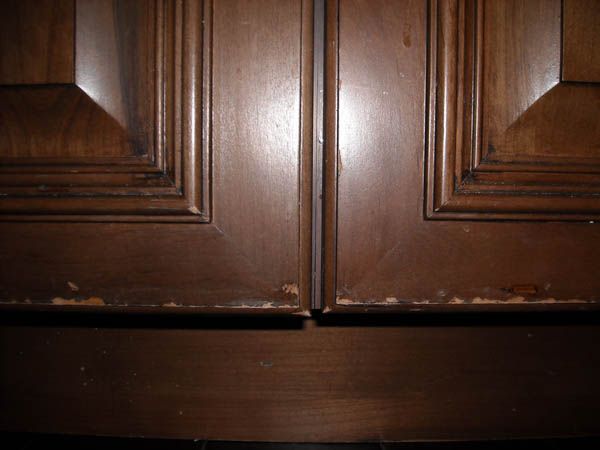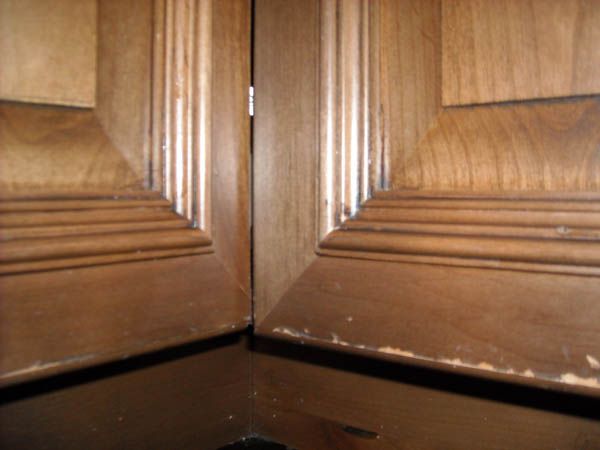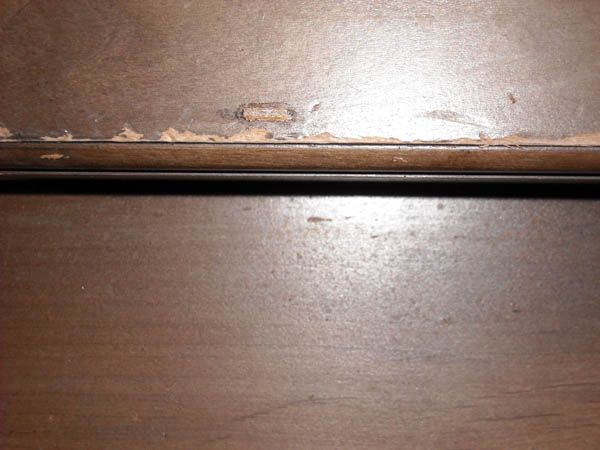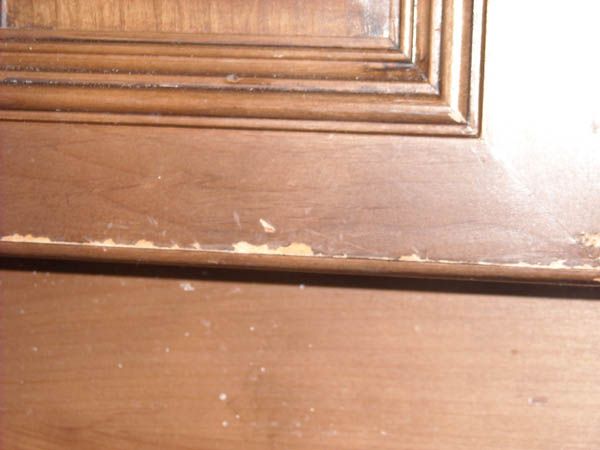Cabinet Door Finish Failure — Diagnosis and Repair
Finishers play detective on a case of finish failure, and suggest fixes. February 13, 2009
Question
I completed a cabinet job about a year ago and just received an email from the customer stating that the finish is coming off in various places. I haven't been up there to see it personally, but she did attach these photos. It does indeed look as if there is a finish problem. Any suggestions? I am afraid I already know the answer. If that is indeed the only way to fix this, what is the best way to strip the doors down?

Click here for higher quality, full size image
Forum Responses
(Finishing Forum)
From contributor G:
It seems from that picture that the finish is lifting from the glaze line. If the problem is only in a few spots, you may be able to do spot repairs. Cross your fingers and go have a look at them.
From the original questioner:
They said that it is pretty much across the whole job, so I think it will involve a refinish. What is the best plan of attack?
From contributor R:
I would think the very first thing to do would be to figure out why the finish failed so you don't do the same thing again. Do you know what the original finish schedule was?
From contributor N:
I'm not a refinishing expert, but have done numerous projects. I would think that purchasing/making new doors would be to your advantage. The labor and material to strip will, I think, be higher than the door cost. And I've had more than enough problems going over stripped material with conversion varnishes. Either way, no fun, no money.
From the original questioner:
Contributor R, yes, I agree. I do know what the finish schedule was. I am trying to remember that long ago, but I think I may have let the glaze dry too long before recoating or possibly missed the recoat window for the pre-cat. I seem to remember a large number of doors that I pushed it on. Could either one of those be the case from the picture I posted?
Finish schedule...
1. Seal coat
2. VanDyke brown glaze
3. Toning coat (2 coats) - heavily reduced finish with small amount of stain
4. Clear coat
I have done this finish numerous times, including my own office furniture a couple of years ago, and have never had this problem before. So I don't think it is the product. The only variable I think it may be is the time between steps. Could that be it?
Also, do you believe ordering more doors and starting over would be more cost effective? I have never had to strip down and start over, so I don't know how much time I am looking at.
From contributor C:
All bottom edges? Water damage. Failing finish knows no up, down, or sideways. As long as you broke your edges - so they aren't sharp - I would make the customer pay for half the refinish. I have done a lot of expert witness work for both homeowners and cabinet shops, so I've seen a lot of this.
From contributor H:
Are these the bottom edges of base
cabinet doors?
From the original questioner:
I believe so. She said it is more prevalent in this location but said the finish scuffs off easily everywhere. Here are some more pictures.

Click here for higher quality, full size image

Click here for higher quality, full size image

Click here for higher quality, full size image
From contributor W:
Wow, that looks like a lot of work. Applied molding doors with miter corners are expensive. It looks like you have an adhesion problem between your clear sealer and the toner. The most likely culprit is the glaze or missed window. The thinned down tone coat could be at fault as well. It would be better to use more finish in the toner coats. I would try to strip a couple of pieces with lacquer thinner first and maybe acetone or MEK. If that does not work, then try some gel stripper and wash with paint thinner and steel wool. Short of that, you might contact a furniture refinishing company for a vat stripping bulk price. Make sure you wash everything down with xylene before finishing. You might have to add a fisheye remover when you refinish because of contamination by furniture polish.
From the original questioner:
I'd like to find a furniture refinishing company that is set up to bulk strip down old finish. Any ideas on who would do that? Is it more cost effective to buy new doors or strip and refinish?
From contributor G:
If you go to a commercial stripper, remember that if they use NaOH in the vat, it will darken your cherry.
From contributor B:
I believe it's definitely an adhesion problem and stripping is the only right way to go. Now there are stripping alternatives available. Don't vat strip! Use a flow-over type of stripping, with methelene chloride based chemical. There are refinishers of furniture that do this type of stripping. I have one of these strippers that I have used for the same purpose. I believe it would be a fairly easy job (stripping falling off kind of thing) for them to do.
From contributor J:
That is correct. Look for a stripping company that uses the flow over system and methyl chloride as their stripping agent. This will not darken the cherry. I do a ton of doors every year. I use a local company that charges me anywhere from $15 to $25 a door depending on size, finish, etc. They come out super clean. When I get them back I wipe them down with lacquer thinner or xylene. Then I continue with the finishing process as I would with a new door. I wouldn't think you could replace the doors for less than that.
From contributor S:
That is some serious finish failure. It looks, in the pictures anyway, that it is only showing up where there are applied moldings, applied edges, and at the miters. Any chance someone was sloppy about removing the glue squeeze out?
If it is really coming off that easily overall, you could possibly remove much of the coating with tape. May sound silly, but it works very well on some adhesion failures. Rub it down well and rip it off. You may end up with very little left that requires pulling out chemistry to strip.
From contributor P:
Is the damage all at the bottom edge of the lower
cabinet doors? Right where the vacuum cleaner or steam cleaner might rub the finish off? I see plenty of scuff marks around the peeling areas. Looks like owner damage from here.
I agree that if the finish was seriously flawed, to the point of falling off, it would not be isolated to the bottom edges. There would be failure throughout the surface of the door. Look at all the glaze in the corners of the raised panel. That has to be the weakest area of the finish.
I'd go inspect the damage in person and up close. Take a loupe with you, and inspect the "failure" closely. You could even do a cross-hatch adhesion test just above the peeling finish to see if it's weak.
If the damage is the customer's fault, you can work with them to decide how much you're going to get paid to do some touchups.
From the original questioner:
I do need to see it personally but will not be able to for a week (out of town). I just want to be prepared. She says that it is coming off easily everywhere (if it is lightly scuffed it will scrape right off). So I am wondering if it is just more prevalent down low on the base doors because it would be bumped more often. I will make sure it is finish failure before I do it at my loss, but I want to be prepared for what I may have to pay. My gut feeling tells me it is finish failure for the reason that they seem to be very careful with their property and seem very honest, but we will see.
From contributor D:
As some of the previous posts have stated, flow over stripping with meth chloride is the way to go, but be forewarned, depending on which clear coat you used, this may or may not be an easy strip job. If you used CV, 2K poly or any other catalyzed finish it will require more than a little effort to remove the finish except in the loosened spots. It can still be done, it will just take some effort and cost a little more than if the clear coat was NC lacquer.
Being in the finish/refinish business for 20+ years I have seen this occur many times. Sometimes it turned out to be bad product, improper catalyzation, poor finish schedule and yes, even client mistreatment.
Looking at the pictures I notice one thing. The damage seems to be consistently at one location on all the doors. That is at the bottom moulding to rail point of attachment. There are other similar areas on these doors, such as the panel to rail and stile points, which do not show this damage.
I think it's safe to assume you did not treat these areas any differently than the others? This would lead me to find some other cause. How often and with what chemicals or processes were the cabinets cleaned? Do these clients employ a cleaning service or person?
Are the affected doors on cabinets that come in constant contact with water or steam (above or next to dishwasher or built in coffee equipment), below or next to a sink? Are they along the floor where careless mopping can cause issues?
Visit the property and make a visual note of all the areas and then start the process of elimination. There will be a logical reason for this failure. You will need to do your homework and come up with it.
From contributor S:
Actually, looking again, it does look as if all these pictures may be the bottom edge of doors on the base cabinets. If that is the case, then I agree that this looks like it could be a bang up job by the homeowner. You'll know when you get there.
From contributor O:
Take a closer look at all the pictures. If this is/was user damage caused by cleaning or whatever, why isn't the high spot or the front of the applied molding not damaged? Looks to me as if the damage is located at the intersection where the applied molding meets the stiles/ rails. This would indicate an area where the glaze or the coatings pooled. Why it's damaged at those areas is up for grabs, could be too much finish in those areas or the glaze was too wet or too dry when it was sealed. Could also be caused by lack of finish. The "tape" test could be performed on the field area of the door or drawer. I don't think this type of damage could be traced back to the owner.
From contributor S:
When I pull the photos up in high def, doesn't it almost look like the stiles/rails are just slightly proud of the applied edges and moldings? Also the edges appear to be quite radiused, almost from the point of attachment, so maybe they are just not taking the hit.
Then also, it almost looks like there are torn raw wood fibers showing. Torn fibers are abuse, not finish failure.
And on the original post picture, on the right door just above the raw edge is an oblong shaped mark which seems to have a dark outline and an orangey center color, kind of looks like an attempted touch up with some goofy product, like old English or something that would pool dark at the edge of the coating and stain up that color on the raw.
I'm just not seeing any sign of a fat edge. Doesn't mean there isn't an adhesion problem factor in play here, but it really does look like it is in places where it is taking a direct hit. I don't think the questioner is going to know what's up for sure until he gets there and can look with his own eyes and do his own testing.
From contributor G:
Forensically-speaking, there are other signs of abuse. There are drips down the door and the stile in the first pic, like something had spilled down the front of the cabinet. If liquid spilled or soapy wiping cloths were washed down the doors without being dried off, moisture could get under the film where it pooled - atop the moldings. It seems like this kitchen gets a lot of use - looks rubbed and far older than one year. Are there children? I've never been a fan of getting all your color from shading lacquer for exactly this reason - any damage and you're looking at bare wood.
From contributor R:
The first thing I notice is that there is no stain on the door.
"Finish Schedule. . .
1. Seal coat
2. VanDyke brown glaze
3. Toning coat (2 coats) - heavily reduced finish with small amount of stain
4. Clear coat"
What is seal coat? Are you using shellac, vinyl sealer or something else? What brand of pre-cat? (Also with pre-cat, the stripping shouldn't be too difficult, especially if there is an adhesion problem.) When you do this finish again, you may want to apply a stain to the bare wood first to get at least 2/3 of the color you are after. This will let you cut down on the glaze and shading and if there is a chip, it won't show as a bare wood spot.
I also would do an adhesion test when you visually inspect the job. Do one on the face and one on the back of the door. Another thing to look for is if the failure occurs only in wet areas (like below the sink).
From contributor B:
While we are trying to determine what caused the failure, the fact remains of what to do now. I still say strip and refinish or buy new doors and finish from scratch. There shouldn't be any question as to doing a touchup or repair other than that.
From contributor A:
Find out who cleans the house. If they have a housekeeper, she may be cleaning the cabinets with an aggressive product. Regardless of possible systemic film failures, that is an incredible amount of consistent physical damage to the doors. Do the customers have kids? It appears that something has been whacking the bottom of the doors.
From contributor M:
There is a good chance that this finish may have been over catalyzed, over glazed, and poorly sealed. You're going to have to make that decision after you have seen the pieces.
From the original questioner:
Thanks for all the feedback Is Parks Woodworking a source for possibly stripping the doors? I am out of town for another week but will inspect as soon as I return. I am planning for the worst, though.
From contributor I:
That piece of molding could be loose also.
From contributor Y:
My guess on this is that they either used a very wet towel to clean the cabinets and left water pooled on those spots in the profile on a regular basis, or they dripped water on the doors on a regular basis from something they were doing like setting a dog's water bowl there. The water eventually weakened the finish and then got behind it and caused it to release. An excess of glaze in the profiles can assist this process and could be a contributing factor.
If I were to inspect, along with the cross/hatch test, I would also run my thumb nail along the same profiles on the top of the door and see if the finish flakes off. If not, then I would say something happened that the client isn't owning up to. If it does flake off, you will know the glaze was at least a part of the problem.
The comments below were added after this Forum discussion was archived as a Knowledge Base article (add your comment).
Comment from contributor A:
I would look closely in the customer's home for evidence of repeated use of "blue" ammonia based cleaners - Windex and etc. These will eventually strip or weaken even a good finish. These cleaners are the bane of suppliers to the restaurant trade. It's a tough call especially in light of the owner or manager's desire for "sanitation". If this is the case, however, I would be reluctant to shoulder the full load for a refinish.
Comment from contributor B:
Poor adhesion - no doubt of that. You will have to strip and refinish them. Whatever use or abuse the owner is putting the cabinets through should not cause the damage pictured. First, stop sealing the wood before applying your stain/glaze. Your stains and glazes achieve the best adhesion going on bare wood. Second, stop using glaze like a stain. It is formulated to be brushed on then wiped off, not to be rubbed on and left on. Unless you have aggressively scarified the surface beforehand, you will get virtually no adhesion. Third, if the glaze was oil based or contained any wax, you cannot use pre-cat directly over it. It may dry evenly over it, but the adhesion will be very poor. Use a barrier coat between the base color and the clear (wax free shellac). Strip it in the evenings maybe to minimize your loss.
Comment from contributor C:
It is my opinion that some kind of chemical was splattered on the doors in the pictures. The pooling above the bottom edge is self explanatory. I support my opinion by the spotty damage surrounding the obvious areas. I really don't see how this could have happened otherwise. A failed finish would not have areas that appear as if something "burned" through the finish, especially apparent in the picture number three.
Comment from contributor D:
Everyone has supplied good observations, but this is not a customer problem. I have seen and personally experienced this problem before. It is a severe case of delamination of dissimilar products and stretching the open time for covering your glaze. It will happen more often on this type of door where heavily molded areas can collect or pool your glaze and precat.It is always there but does not rear its ugly head until it gets the least amount of contact. So please don’t blame the homeowner, but learn from the experience.
Shorten your open time in covering the glaze and if you must use those toners try sealer inbetween to help bind the materials as you build color. I am also a fan of dying/staining the wood to help initiate some color towards my final tone. Although you must match the face frames so follow your recipe but pay attention to your film building. Stripping is by far the way to go. New cherry doors will far outweigh the cost of a good strip job, and yes as they all told you overflow is the way to go.
Comment from contributor E:
I don't know of any kind of stain that you can make a durable tinting lacquer out of.
I re-finish cabinets for a living and have had serious finish failures from putting stain other than dye stain anywhere in the schedule except on prepared raw wood. Dye stain can be sprayed over the first sealer (use compatible products). I use Ml Campbell’s products mostly. Their dye stain is not mixable with lacquer. It will remain gummy and cause cratering.
To make a strong tinting lacquer I use up to 8% Deguzza 844 toner in semi gloss magna-max pre cat lacquer. Thin it a lot, up to 70%. Spray tint lightly just to wet with each pass. Then put on two coats of lacquer with sanding between.



